Alena Dergiliova The Exibitor Of The Salon “ART EN CAPITAL” France, Paris, 2014

I was born in a one-story merchant house at Taganka. The house stood on the corner of Vorontsov street which still had trams back then, and Mayakovsky alley. The end of that alley was once home of poet Vladimir Mayakovsky. My grandmother told me how she met him on the street many times, with a cane and hat, walking home with a flourish. Streets of cobblestone and asphalt came later. At the corner there is a column with artesian water, which are now found in the provinces and have disappeared from Moscow in the sixties. The courtyard is a classical Moscow type, surrounded by a dense, high fence with a gate still hanging on large hinges, and with gateways on both sides. Two huge, ancient trees, behind whose trunks playing children would hide, are still standing. This is the only thing that survives today from those times.
While walking through the old Moscow, my eyes unerringly catch pieces and corners that are not yet affected by the “restructuring”, carrying within them a century of history. Many of my watercolors of Moscow houses are “portraits”, for example: “Sivtsev Vrazhek, 6?, “Crickets Lane”, “Yauza Boulevard.” What is important to me are the details that help to accurately convey what is planned. The watercolor “On the street Solyanka” is a portrait of a piece of an old fence, worldly-wise and living its last few years. Now there are irreversible changes in our environment, that are probably necessary. It is very painful, like the passing of loved ones.
Alena Dergiliova for the readers of the ”Russian Art & Paris”.
Alena Dergiliova is one of the most prominent Russian graphic artists, that are acutely aware of the “aura” of objects, their primary energy. It catches the eye of viewers, who observe the artwork for long periods of time, filled with hidden power. Outwardly, they are harmonious, but include a lot of dissonance that creates worry. In Soviet times, Dergiliova was breaking free from the strict ranks of “Varnishers” with the reality of being “disheveled” and lack of heroism in her scenes. In the format of what is called “new” art in modern Russia, she is not radical enough, does not wander around the labyrinth of the subconscious and does not create art for the decoration of walls.
• A significant virtue of the artwork is the objectivity of life in the perception of reality. Personally heartfelt and hard-won artistic senses are formulated into a complete image. These features can be very beautiful or not very pleasant, but they are quite familiar
• Moscow was portrayed by many famous Russian artists. Every age gives rise to new art creators. We know the graphic art of A. Vasnetsov dedicated to recreating the ancient landscape of the city. We remember the 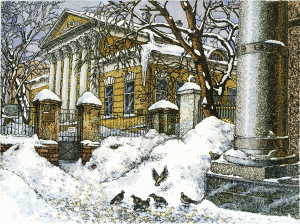 canvases of Y. Pimenov, filled with the joy of sensations of the advent of new residential areas, watercolors of V. Alfeevskiy and K. Kupecio. The beauty of the architecture of Moscow is still today trying to be captured by many graphic artists and painters. However, the changes in Moscow in real time are so significant, that they require the deepest possible understanding of what is happening, by means of art. The complexity and tenderness of these changes can only be felt by an artist, not just living in Moscow and worrying about her fate, but also drawing daily the constantly changing face of the beloved city.
canvases of Y. Pimenov, filled with the joy of sensations of the advent of new residential areas, watercolors of V. Alfeevskiy and K. Kupecio. The beauty of the architecture of Moscow is still today trying to be captured by many graphic artists and painters. However, the changes in Moscow in real time are so significant, that they require the deepest possible understanding of what is happening, by means of art. The complexity and tenderness of these changes can only be felt by an artist, not just living in Moscow and worrying about her fate, but also drawing daily the constantly changing face of the beloved city.
• Such an artist, with heart tied to Moscow, is Alena Dergiliova. A series of watercolors “My Moscow”, created over the last fifteen years, is the most striking and significant phenomenon in her work. The series consists of 100 watercolors that reflect life in historic districts as well as the characteristic features of modern urban ensembles. Four 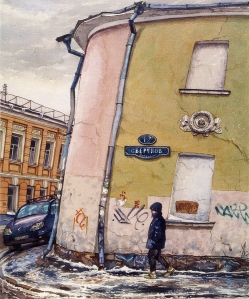 scenic blocks: “Metropolitan life”, “Old streets”, “Gentry Moscow”, “Stalin’s Moscow” allow the viewer to fully immerse himself in the multi-level world of this city. A distinctive feature of the series is the construction of compositions in the form of a pictorial space in which people, houses, streets and squares of the capital all act as equal characters, creating a feeling of a “live” city.
scenic blocks: “Metropolitan life”, “Old streets”, “Gentry Moscow”, “Stalin’s Moscow” allow the viewer to fully immerse himself in the multi-level world of this city. A distinctive feature of the series is the construction of compositions in the form of a pictorial space in which people, houses, streets and squares of the capital all act as equal characters, creating a feeling of a “live” city.
• The watercolors of Dergiliova differ from the scenic and graphic works of other contemporary authors representing Moscow and other capitals of the world, by their complex scenic intertwining. The deliberate and professional use of symbolism of the mundane gives the watercolors credibility and depth. The image-symbol may have the widest meaning and leads viewers to the essence of phenomena by forms of expression that externally are not heroic. The artworks of Alena Dergiliova are not cityscapes with staffage but rather intricately lined paintings with action, unfolding in a particular historical or contemporary urban environment. In order to understand her work it is necessary to move away from internal complacency, and only then will the external ordinariness of the presented action be revealed in the form of a controversial and not always comfortable life.
by Nikolay Beschastnov, Ph.D. in Art History
Director of the Art Institute of Moscow State University of Design and Technology
____
Pictures in the text (from above):
“Palace of Aksakov” Etching. (28 x 21 cm); “Sverchkov Pereulok” Watercolor. (70 x 52 cm).
.
.
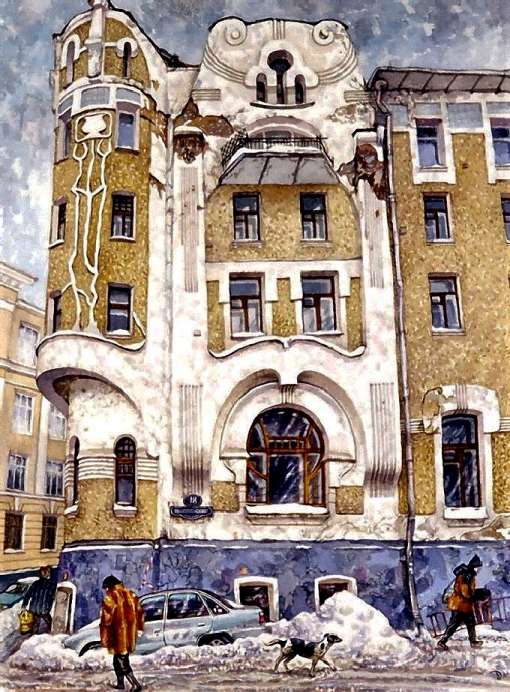 “Podsosenskiy Pereulok” Watercolor. (78 x 58 cm)
“Podsosenskiy Pereulok” Watercolor. (78 x 58 cm)
.
.
* * *
The graphic art of Alena Dergiliova is difficult to define in a few words. The phrase “lyrical grotesque” will probably sound strange and unusual, especially in relation to an graphic-artist working in the classical techniques of etching and watercolor. The point, apparently, is not in the accuracy of the formal wording. Value is contained foremost in the quality of the art form, in which the thoughts and feelings of the artist are served. Expectations for etching are traditionally very high. This kind of graphic art is best not approached without a virtuoso technique – an amateur can be discerned at a glance. Yet technical skills alone do not turn a sheet of paper passed through the etching press into an etching. A genuine charm, a unique aura of etching occurs only if there appears a scene that is not depleted, but rather enriched, by the black-and-white image. It is hard to say which has greater meaning – the ability of the artist to see an etching motif in the world around him, or a particular feel for the etching board on which the essential details required for etching will be revived. In addition, a black-and- white image has a unique feature – it is concentrated on only the main idea, only the essence of the depicted scene. No dispersion or verbosity, one who is not able to separate the essential from the secondary – will never create a real etching.
• “Apple tree” is an etching by Alena Dergiliova, that is one of the most classical in form. The plot appears as a conflict between two harmonious forms, united into a single space. There are live forms, created by nature, such as tree branches and 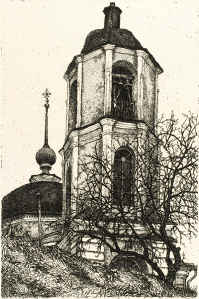 artificial forms, created by man, like the Cathedral bell tower. Compositionally this conflict is developed through black color – the movement of large masses of black (Cathedral bell tower) and the tremulous, translucent graphics of black branches. The compositional conciseness drastically enhances the natural qualities of black and white, its inner nature – topicality, the focus on sincerity, and the accuracy – at least from the author, at most from the event. There appears an effect, present here and now, equivalent to the philosophical category – “grasp”. Thus, the artistic decision – the selection of the moment filled with meaning, creates a sense of belonging in the event. There arises a contact of the artwork with the viewer, and their dialogue begins. The importance of this dialogue is determined in equal amounts by both participants. The energy of the artistic image, its aesthetic and intellectual depth, determine the quality of the artist’s work. The reading of an artistic image, its description – is the work that must be done by the viewer. The small etching “Apple tree” is the quiet sadness of autumn, fallen leaves, old Cathedral walls; it is the fate of generations who have touched these walls, it is the finiteness of life in the infinity of existence.
artificial forms, created by man, like the Cathedral bell tower. Compositionally this conflict is developed through black color – the movement of large masses of black (Cathedral bell tower) and the tremulous, translucent graphics of black branches. The compositional conciseness drastically enhances the natural qualities of black and white, its inner nature – topicality, the focus on sincerity, and the accuracy – at least from the author, at most from the event. There appears an effect, present here and now, equivalent to the philosophical category – “grasp”. Thus, the artistic decision – the selection of the moment filled with meaning, creates a sense of belonging in the event. There arises a contact of the artwork with the viewer, and their dialogue begins. The importance of this dialogue is determined in equal amounts by both participants. The energy of the artistic image, its aesthetic and intellectual depth, determine the quality of the artist’s work. The reading of an artistic image, its description – is the work that must be done by the viewer. The small etching “Apple tree” is the quiet sadness of autumn, fallen leaves, old Cathedral walls; it is the fate of generations who have touched these walls, it is the finiteness of life in the infinity of existence.
• The stylistics of graphics by Alena Dergiliova are sincere, almost intimate – derived from the soft, “spoken” rhythm of most compositions. An artist leads his creative narrative to the rhythm of a home conversation – without raising his voice, avoiding sharp accents. A particular role in this is played by the knowledge of that which is the subject of the image. When a person believes in his own truth, he is not inclined to get short-tempered, even in a dispute. To learn and to understand that which you are depicting is a necessary condition for an image to have meaning. A slow movement from form to meaning is starting to appear in the art of our time. It is a difficult movement. Modern audiences are unaccustomed to meaning. The problem is that the absence of meaning leads to a degradation of feelings. The acquaintance with the art of Moscow artist Alena Dergiliova, artwork filled with feelings and meaning is a good reason to think about it. ©
by Russian Art & Paris
____
Picture in the text: “Apple tree” Etching. (21 x 15 cm)
.
.
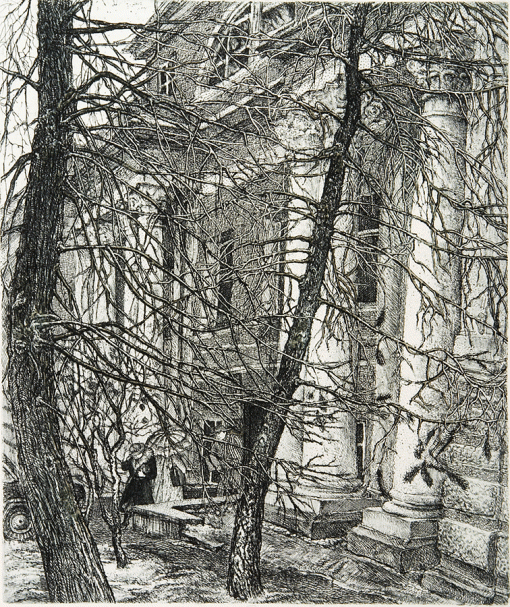 “Palace of Denis Davydov” Etching. (37 x 30 cm)
“Palace of Denis Davydov” Etching. (37 x 30 cm)
.
“The graphic art of Alena Dergiliova can certainly be called traditional: etching and watercolor by technique; urban landscape and portrait by genre; and finally, it is traditional by her artistic language, by the honest natural image without the aftertaste of styling, by the concreteness in the transmission of visual impressions. The artist does not hide the avid interest towards that which she represents, to the motive or character, whether it is a living person or a house in any of Moscow’s alleys (which is also lively in it’s own way, spirited and eccentric). This entire house, or more often only a small fragment, some quaint bay window, a massive staircase, an arch above the yard, windows in Sverchkov Lane – all this has some particular feature, everything is familiar, recognizable and often loved. Most often it is that quiet Moscow, where not every house is “a monument of architecture” of some old century. However every house is a surviving page of city life, of its intimate stories. Every house is the keeper of the memory of city and family life”.
Yuriy Gerchuk,
Honored Artist of the Russian Federation, art critic.
.
Alena Dergiliova was born (1952) and raised in Moscow, in the artists’ family. Graduated from Moscow Textile University in 1975. The artist trained at the creative academic studios of the USSR Academy of Arts, under the guidance of academician Orest Verejskiy. Alena Dergiliova is a member of the Artists’ Union of Russia since 1983. Artist received the Medal of the Russian Academy of Arts in 2007. The works of Alena Dergiliova – etching and watercolor are in the collections of museums: The State Tretyakov Gallery (Moscow), The State Historical Museum, The Museum of History of Moscow, The Leo Tolstoy’s museum.
link on the article:
http://russianartparis.com/2015/01/15/artist-alena-dergiliova-moscow/

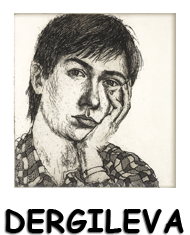

 Русский
Русский

